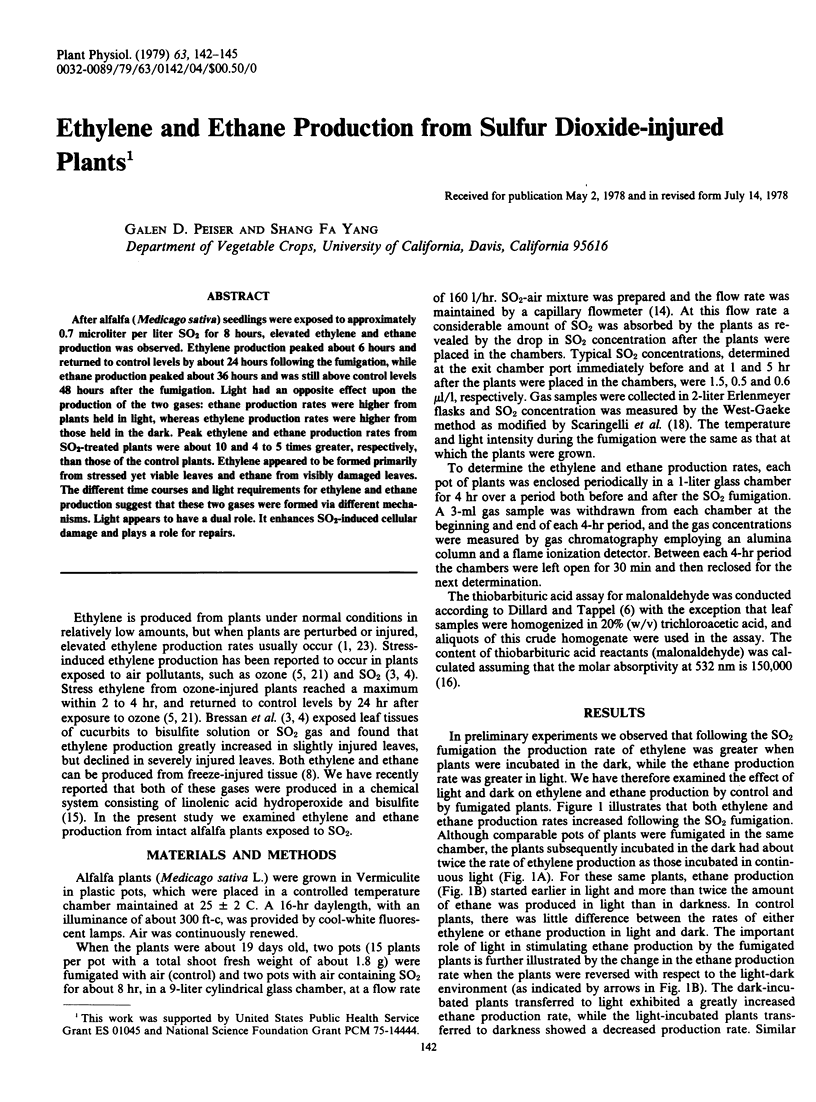Abstract
After alfalfa (Medicago sativa) seedlings were exposed to approximately 0.7 microliter per liter SO2 for 8 hours, elevated ethylene and ethane production was observed. Ethylene production peaked about 6 hours and returned to control levels by about 24 hours following the fumigation, while ethane production peaked about 36 hours and was still above control levels 48 hours after the fumigation. Light had an opposite effect upon the production of the two gases: ethane production rates were higher from plants held in light, whereas ethylene production rates were higher from those held in the dark. Peak ethylene and ethane production rates from SO2-treated plants were about 10 and 4 to 5 times greater, respectively, than those of the control plants. Ethylene appeared to be formed primarily from stressed yet viable leaves and ethane from visibly damaged leaves. The different time courses and light requirements for ethylene and ethane production suggest that these two gases were formed via different mechanisms. Light appears to have a dual role. It enhances SO2-induced cellular damage and plays a role for repairs.
Full text
PDF



Selected References
These references are in PubMed. This may not be the complete list of references from this article.
- Abeles A. L. Biochemical Pathway of Stress-induced Ethylene. Plant Physiol. 1972 Oct;50(4):496–498. doi: 10.1104/pp.50.4.496. [DOI] [PMC free article] [PubMed] [Google Scholar]
- Bressan R. A., Wilson L. G., Filner P. Mechanisms of resistance to sulfur dioxide in the Cucurbitaceae. Plant Physiol. 1978 May;61(5):761–767. doi: 10.1104/pp.61.5.761. [DOI] [PMC free article] [PubMed] [Google Scholar]
- Dillard C. J., Tappel A. L. Fluorescent products of lipid peroxidation of mitochondria and microsomes. Lipids. 1971 Oct;6(10):715–721. doi: 10.1007/BF02531296. [DOI] [PubMed] [Google Scholar]
- Dumelin E. E., Tappel A. L. Hydrocarbon gases produced during in vitro peroxidation of polyunsaturated fatty acids and decomposition of preformed hydroperoxides. Lipids. 1977 Nov;12(11):894–900. doi: 10.1007/BF02533308. [DOI] [PubMed] [Google Scholar]
- FRIDOVICH I., HANDLER P. Detection of free radicals in illuminated dye solutions by the initiation of sulfite oxidation. J Biol Chem. 1960 Jun;235:1835–1838. [PubMed] [Google Scholar]
- Hanson A. D., Kende H. Biosynthesis of wound ethylene in morning-glory flower tissue. Plant Physiol. 1976 Apr;57(4):538–541. doi: 10.1104/pp.57.4.538. [DOI] [PMC free article] [PubMed] [Google Scholar]
- Hyodo H. Ethylene Production by Albedo Tissue of Satsuma Mandarin (Citrus unshiu Marc.) Fruit. Plant Physiol. 1977 Jan;59(1):111–113. doi: 10.1104/pp.59.1.111. [DOI] [PMC free article] [PubMed] [Google Scholar]
- Jablonski P. P., Anderson J. W. Light-dependent Reduction of Oxidized Glutathione by Ruptured Chloroplasts. Plant Physiol. 1978 Feb;61(2):221–225. doi: 10.1104/pp.61.2.221. [DOI] [PMC free article] [PubMed] [Google Scholar]
- John W. W., Curtis R. W. Isolation and Identification of the Precursor of Ethane in Phaseolus vulgaris L. Plant Physiol. 1977 Mar;59(3):521–522. doi: 10.1104/pp.59.3.521. [DOI] [PMC free article] [PubMed] [Google Scholar]
- Placer Z. A., Cushman L. L., Johnson B. C. Estimation of product of lipid peroxidation (malonyl dialdehyde) in biochemical systems. Anal Biochem. 1966 Aug;16(2):359–364. doi: 10.1016/0003-2697(66)90167-9. [DOI] [PubMed] [Google Scholar]
- Riely C. A., Cohen G., Lieberman M. Ethane evolution: a new index of lipid peroxidation. Science. 1974 Jan 18;183(4121):208–210. doi: 10.1126/science.183.4121.208. [DOI] [PubMed] [Google Scholar]
- Scaringelli F. P., Saltzman B. E., Frey S. A. Spectrophotometric determination of atmospheric sulfur dioxide. Anal Chem. 1967 Dec;39(14):1709–1726. doi: 10.1021/ac50157a031. [DOI] [PubMed] [Google Scholar]
- Schönherr J. Plant Cuticles Are Polyelectrolytes with Isoelectric Points around Three. Plant Physiol. 1977 Feb;59(2):145–150. doi: 10.1104/pp.59.2.145. [DOI] [PMC free article] [PubMed] [Google Scholar]
- Tingey D. T., Standley C., Field R. W. Stress ethylene evolution: a measure of ozone effects on plants. Atmos Environ. 1976;10(11):969–974. doi: 10.1016/0004-6981(76)90204-3. [DOI] [PubMed] [Google Scholar]


